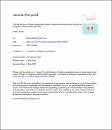The identification of highly upregulated genes in claudin-low breast cancer through an integrative bioinformatics approach
| المؤلف | Hatem, Zayed |
| تاريخ الإتاحة | 2020-06-11T05:19:45Z |
| تاريخ النشر | 2020-05-30 |
| اسم المنشور | Computers in Biology and Medicine |
| المعرّف | http://dx.doi.org/10.1016/j.compbiomed.2020.103806 |
| الاقتباس | : H. Zayed, The identification of highly upregulated genes in claudin-low breastcancer through an integrative bioinformatics approach, Computers in Biology and Medicine (2020), doi:https://doi.org/10.1016/j.compbiomed.2020.103806. |
| الرقم المعياري الدولي للكتاب | 0010-4825 |
| الملخص | Breast cancer (BC) is one of the leading causes of cancer-related death among women worldwide, and claudin-low breast cancer (CLBC) is a subtype of BC that remains poorly described. This study aimed to identify upregulated genes and significant pathways involved in CLBC. The SUM159 cell line is derived from human CLBC tissue; the GSE50697 dataset contains three replicates of SUM159 cells treated with pBabe puro miR-203 and three replicates of control SUM159 cells (pBabe puro). The data were normalized and upregulated, and downregulated genes were identified based on the logFC values. Gene Ontology (GO) and pathway analysis identified the most significant pathways and genes involved in CLBC pathogenesis. A total of 156 significant genes were identified (69 upregulated genes and 64 downregulated genes). From the pathway analysis, the senescence-associated secretory phenotype, which involves the CXCL8, IL1A, and IL6 genes, was found to be mapped through more than one pathway (WikiPathways and Reactome). From the refined GO analysis, the IL-13 signaling pathway was identified; this pathway includes the IL6, CXCL8, VEGF-C, NRG1, and EREG genes, which were mapped as hub genes in several pathogenesis pathways. From the survival analysis, high levels of IL6, CXCL8, and EREG were related to high survival rates, and low levels of VEGFC and NRG1 were related to high survival rates. The IL6 and CXCL8 genes were the most significant and the most highly represented in the GO and refined GO analyses. This study might provide a potential biomarker for the treatment of CLBC. |
| اللغة | en |
| الناشر | Elsevier |
| الموضوع | Breast cancer Microarray Claudin-low breast cancer Biomarkers Functional enrichment analysis Differential gene expression |
| النوع | Article |
| Open Access user License | http://creativecommons.org/licenses/by/4.0/ |
تحقق من خيارات الوصول
الملفات في هذه التسجيلة
هذه التسجيلة تظهر في المجموعات التالية
-
العلوم الحيوية الطبية [763 items ]



